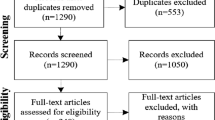Abstract
This paper addresses how to assess and improve the user experience design of hospital applications for their customers in mobile and wireless environments. To broadly understand the new functionalities and emotional user requirements of mobile hospital applications from a user experience perspective broadly, we elicit crucial user requirements for mobile hospital applications using the evaluation grid method (EGM). Additionally, we suggest a guideline for improvement using a hierarchical value map and biplot analysis.







Similar content being viewed by others
References
Ahn, M. J., Yang, J. Y., Ryu, H. S., & Park, C. S. (2013). A case study of a mobile hospital information system usability. Korean Journal of Hospital Management, 18(4), 97–112.
Brahami, M., Atmani, B., & Matta, N. (2013). Dynamic knowledge mapping guided by data mining: application on healthcare. Journal of Information Processing Systems, 9(1), 1–30.
Cha, H., & Kim, J.-H. (2013). An evaluation model of transition PMO competencies using RGT and AHP. Journal of Information Technology Services, 14(2), 87–109.
Cockton, G. (2004). Value-centred HCI. In Proceedings of the 3rd Nordic conference on Human-Computer Interaction, (pp. 149–160). October 2004.
Fallman, D., Waterworth, J. (2005). Dealing with user experience and affective evaluation in HCI design: A repertory grid approach. CHI Workshop Paper, (pp. 2–7).
Følstad, A., Hornbæk, K., & Ulleberg, P. (2013). Social design feedback: evaluations with users in online ad-hoc groups. Human-centric Computing and Information Sciences, 3(1), 1–27.
Fransella, F., Bell, R., & Bannister, D. (2004). A manual for repertory grid technique. West Sussex: Wiley.
Gabriel, K. R. (1971). The biplot graphic display of matrices with application to principal component analysis. Biometrika, 58(3), 453–467.
Hair, J. F., Anderson, R. E., Tatham, R. L., & Black, W. C. (1998). Multivariate data analysis (5th ed.). Upper Sadle River, NJ: Prentice Hall.
Ihm, H. (2013). Mining consumer attitude and behavior. Journal of Convergence, 4(1), 29–35.
Junichiro, S. (1996). Visualization of users’ requirements: Introduction of the evaluation grid method. In Proceedings of the 3rd Design and Decision Support Systems in Architecture and Urban Planning Conference, (vol. 1, pp. 365–374).
Kailas, A., & Ingram, M. A. (2009). Wireless aspects of telehealth. Wireless Personal Communications, 51(4), 673–686.
Kurosu, M., Kobayashi, T., Yoshitake, R., Takahashi, H., Urokohara, H., Sato, D., et al. (2004). Trends in usability research and activities in Japan. International Journal of Human–Computer Interaction, 17(1), 103–124.
Lee, S. J., & Paik, J. K. (2013). Usability-oriented comparison of GUI designs of general hospital mobile websites. Design Convergence Study, 41, 261–275.
Lee, S.J., Paik, J.Y., & Paik, J.K. (2013). A study on improving mobile website usability of general hospitals using smartphones. In Proceedings of ADADA, (pp. 466–467).
McNaull, J., Augusto, J. C., Mulvenna, M., & McCullagh, P. (2014). Flexible context aware interface for ambient assisted living. Human-centric Computing and Information Sciences, 4(1), 1–41.
Ministry of Health & Welfare. (2014). OECD Health Data 2014. Seoul: Kyung Sung.
Ng, J. K.-Y. (2012). Ubiquitous healthcare: healthcare systems and applications enabled by mobile and wireless technologies. Journal of Convergence, 3(2), 31–36.
Norman, D. (2004). Emotional design: Why we love (or hate) everyday things. Cambridge: Basic books.
Oh, J. S., Kim, H. Y., & Moon, H. N. (2014). A study on the diffusion of digital interactive e-books: The development of a user experience model. Journal of Convergence, 5(2), 21–27.
Peng, K. (2013). A secure network for mobile wireless service. Journal of Information Processing System, 9(2), 247–256.
Reynolds, T. J., & Jonathan Gutman, J. (1998). Laddering theory, method, analysis, and interpretation. Journal of Advertising Research, 28(1), 11–31.
Ravikumar, N., Metcalfe, N. H., Ravikumar, J., & Prasad, R. (2015). Smartphone applications for providing ubiquitous healthcare over cloud with the advent of embeddable implants. Wireless Personal Communications, 86(3), 1439–1446.
Shen, K. S. (2013). Masuring the sociocultural appeal of SNS games in Taiwan. Internet Research, 23(3), 372–392.
Shon, J. G., & Kim, B. W. (2014). Design and implementation of a content model for m-learning. Journal of Information Processing Systems, 10(4), 543–554.
Wang, B. R., Park, J. Y., Chung, K., & Choi, I. Y. (2014). Influential factors of smart health users according to usage experience and intention to use. Wireless Personal Communications, 79(4), 2671–2683.
Acknowledgments
This research was supported by SW Master’s course of hiring contract Program Grant funded by the Ministry of Science, ICT and Future Planning (H0116-15-1005).
Author information
Authors and Affiliations
Corresponding author
Rights and permissions
About this article
Cite this article
Park, J., Kim, JH., Park, EJ. et al. Analyzing User Experience Design of Mobile Hospital Applications Using the Evaluation Grid Method. Wireless Pers Commun 91, 1591–1602 (2016). https://doi.org/10.1007/s11277-016-3193-0
Published:
Issue Date:
DOI: https://doi.org/10.1007/s11277-016-3193-0




